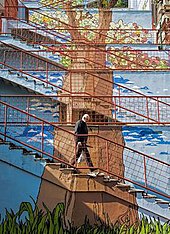
Sarajevo is the capital and largest city of Bosnia and Herzegovina, with a population of 275,524 in its administrative limits. The Sarajevo metropolitan area including Sarajevo Canton, East Sarajevo and nearby municipalities is home to 555,210 inhabitants. Located within the greater Sarajevo valley of Bosnia, it is surrounded by the Dinaric Alps and situated along the Miljacka River in the heart of the Balkans, a region of Southern Europe.

Fudbalski klub Sarajevo is a professional football club based in Sarajevo, the capital city of Bosnia and Herzegovina and is one of the most successful clubs in the country.

Horde Zla is the organized Ultras group that supports Bosnian football club FK Sarajevo. The group's logo consists of a stylized depiction of the Grim Reaper, borrowed from a Zagor comic book at the time of the group's inception. Horde zla is one of two major football fan groups in Bosnia and Herzegovina. Apart from FK Sarajevo, the group also supports KK Bosna Royal and RK Bosna Sarajevo. The group's organizational structure is fairly decentralized with many subgroups present at the stadium's north stand – the gathering point of the club's most loyal and passionate fans. Some of the most well known subgroups are Outlaws, Maroon Brothers, Vutrasi, Fina Gradska Raja and Downtown.
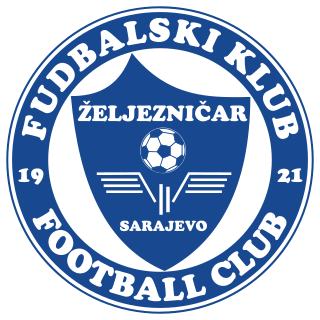
Fudbalski klub Željezničar Sarajevo, commonly referred to as Željo, is a professional football club, based in Sarajevo, Bosnia and Herzegovina. The name Željezničar means "railway worker", originating from their establishment by a group of railway workers in 1921. Throughout its history, the club has cultivated a reputation for producing talented home-grown players through its academy.

A Sarajevo Rose is a type of memorial in Sarajevo made from concrete scar caused by a mortar shell's explosion that was later filled with red resin. Mortar rounds landing on concrete during the siege of Sarajevo created a unique fragmentation pattern that looks almost floral in arrangement, and therefore have been named "rose".

Edin Dervišhalidović, known professionally as Dino Merlin, is a Bosnian singer-songwriter and record producer. Born in Sarajevo, he was the founder and leader of Merlin, which was one of the best-selling rock bands of Southeast Europe.

Damir Nikšić is a Bosnian conceptual artist, standup comedian, blogger and politician. One of his best known art works is a seven-minute-long video entitled "If I wasn't muslim" (2005).
Florijan Mićković was a Bosnian Croat sculptor living and working in Mostar and Međugorje.

The Maniacs are a group of Ultras of the Bosnian football club FK Željezničar Sarajevo. There are also subgroups like Blue Tigers, Joint Union, Urban Corps, Stari Grad, Curva Sud and Vendetta.

The Jazz Fest Sarajevo is an international music festival held annually during the first week of November in Sarajevo and is the largest of its kind in Southeastern Europe.
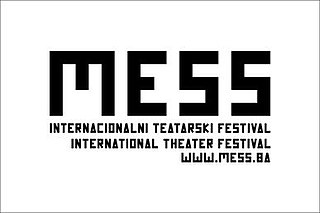
The MESS International Theatre Festival (MESS) is a theatre festival that takes place annually in Sarajevo, Bosnia and Herzegovina. It is the oldest living theatre festival in the Balkans, programming international experimental performances and emerging artists. MESS was the largest theatre festival in the Former Yugoslavia and was named one of Living Theatre's international showcases in 1974. It survived the Siege of Sarajevo, during which it hosted directors such as Susan Sontag and Peter Schumann. It organized the first edition of the Sarajevo Film Festival in 1993 and still acts as a collective board member today. Today it is the largest theatre festival in Bosnia and Herzegovina and one of the largest in South-Eastern Europe. In 2009 it expanded its activities to the city of Zenica, which now hosts parts of the regional program.
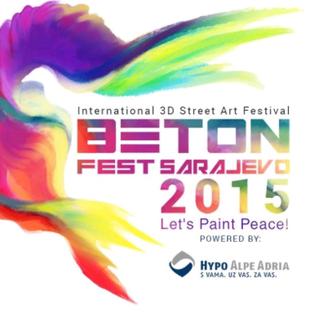
Beton Fest is an international 3D street art festival held annually in Sarajevo, Bosnia and Herzegovina. It is held in July of every year and lasts for five days, bringing in international street artists from all over the world. It was established in 2012 by the arts association Progres in cooperation with the Academy of Fine Arts, Sarajevo. Apart from showcasing 3D street art, it also organizes the Beton Music Stage which holds concerts and open-air parties for the duration of the festival. It is the only 3D street art festival in Southeastern Europe and has hosted many renowned street artists such as Vera Bugatti, Giovanna la Pietra, Tony Cuboliquido, Manuel Bastante and others.

Collegium Artisticum is a contemporary art gallery in Sarajevo, Bosnia and Herzegovina. It was established on 6 April 1975 and was named after the short lived artistic movement of the same name which existed in Sarajevo from 1939 to the start of the Second World War. It was founded as the gallery of Bosnia and Herzegovina’s three major Art Associations – Association of Artists (ULUBIH), Association of Applied Arts and Design (ULUPUBIH) and Association of Architects (AABIH). Today it functions as an Public Institution City Gallery Collegium Artisticum and hosts the annual Collegium Artisticum exhibition.
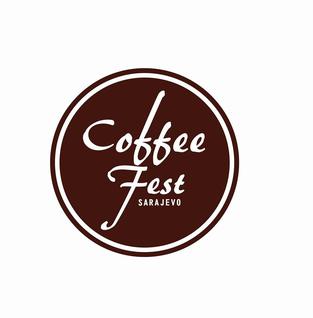
Coffee Fest Sarajevo is an international coffee festival that is held annually in Sarajevo, Bosnia and Herzegovina. The festival was established in 2014 by the Profesional Association in cooperation with the Bosnian Ministry of Trade. Festival partners include Robert Bosch GmbH and Tesla, Inc. It is held in numerous venues across the city, which include the Skenderija Center and MyFace.
The 2019–20 season was Sarajevo's 71st season in existence, and their 26th consecutive season in the top flight of Bosnian football, the Premier League of BiH. Besides competing in the Premier League, the team also competed in the National Cup. Sarajevo competed in the qualifications for the UEFA Champions League, as well as competing in the qualifications for the UEFA Europa League. The season covers the period from 14 June 2019 to 1 June 2020.
The 2020–21 Sarajevo season was the club's 72nd season in existence, and their 27th consecutive season in the top flight of Bosnian football, the Premier League of BiH. Besides competing in the Premier League, the team competed in the National Cup as well. Sarajevo also competed in the qualifications for the UEFA Champions League and the qualifications for the UEFA Europa League.
The 2021–22 Sarajevo season was the club's 73rd season in existence, and their 28th consecutive season in the top flight of Bosnian football, the Premier League of BiH. Besides competing in the Premier League, the team also competed in the National Cup. Sarajevo competed in the qualifications for the UEFA Europa Conference League as well.
The 2022–23 Sarajevo season was the club's 74th season in history, and their 29th consecutive season in the top flight of Bosnian football, the Premier League of BiH. Besides competing in the Premier League, the team also competed in the National Cup.
Edina Papo, born Hadžirović, on 9 April 1958 in Sarajevo. She was the artistic director of the Sarajevo Ballet. As a choreographer and pedagogue, she has made great contributions to the redevelopment and renewal of ballet art in post-Bosnian War Sarajevo, that is, since 1996. She completed her ballet education at Vaganova Academy of Russian Ballet and N. A. Rimsky-Korsakov Saint Petersburg Conservatory in St. Petersburg. She enriched the repertoire with performances closer to the contemporary trends of modern ballet dance and current European theatre.
